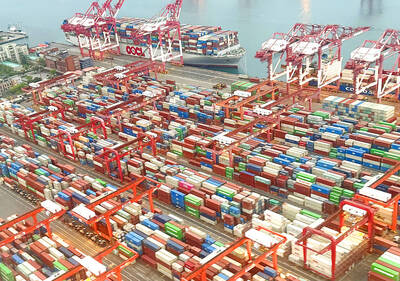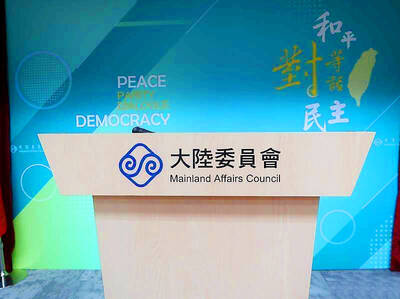Behind the marble facade of its neoclassical fortress on Wall Street, the New York Stock Exchange (NYSE) has been the hub of financial activity in Lower Manhattan for more than a century.
But the buzz emanating from its famous trading floor is dying down as computerized trading has rapidly reduced the need for face-to-face transactions. In the next several weeks, the exchange plans to shut two trading rooms that were added decades ago, when its status as the place to buy and sell stocks was unchallenged.
When the latest retreat is complete, the exchange floor will be half the size it was at its peak in the late 1990s. The "crowd" -- the brokers and clerks on the floor -- has dwindled to about 1,700 from a high of more than 3,000. Before the exchange became a public company in 2005, its members controlled 1,366 seats, or licenses to trade. Now, about 800 brokers pay the annual US$50,000 fee for a license.
"It is certainly not as crowded as it used to be," said Doreen Mogavero, 52, a veteran floor broker, who professed faith in the staying power of the downsized trading floor but admitted that she missed the tingle it used to generate. "There was certainly an electricity that you could feel with people running all around."
The exchange's neighborhood is transforming just as quickly.
Only a few major financial firms, like Goldman Sachs and Bank of New York, still maintain headquarters on or near Wall Street. The blocks nearby, once filled with big-name investment houses, are home to apartments and luxury goods stores like Tiffany and Hermes.
The decline in activity at the exchange's headquarters at 11 Wall Street is palpable. Tourists no longer line up by the hundreds to survey the floor from the visitors' gallery or watch the ceremonial ringing of the opening and closing bells. Excluded for security reasons since Sept. 11, they can only wander by the building that has long symbolized the heart of US commerce.
If they could get inside, they would see that a once-vital organ has been reduced to a reliable backdrop for financial shows on cable. Camera crews flocked there again last Tuesday to capture the reaction to the lowering of interest rates by the Federal Reserve.
But even on its busiest days, the trading floor is a sideshow compared with the center-ring attraction it was several years ago. Most of the action in shares listed on the NYSE happens electronically, between the computers of traders at brokerage houses, mutual fund companies and home offices in spare bedrooms.
The instantaneous execution of trades those computers allow has diminished the value of much of what the humans on the exchange floor used to do. For the last several months, the floor has accounted for less than half of the trading in the 2,700 stocks listed on the exchange. Three years ago, that share was about 80 percent.
"The floor as we knew it is dead," professor of finance at Georgetown University, James Angel said. "The old days when Billy would trade with Vinny and swap information about orders so that they could get a better price for their customer are gone."
At the core of the old system was a small army of specialists, who staffed trading posts and were responsible for maintaining orderly markets in particular stocks. The specialists stand ready to buy or sell stocks with their own money, if necessary. But lately, that need arises less and less often.
This summer, specialists were involved in less than one of every 30 trades, down from about one of every seven just five years ago, according to exchange statistics. Brokers on the floor, who carry out customers' orders to buy and sell shares, handled an additional four of those 30 trades. The other 25 orders happened without a middleman.
With demand for their services dwindling, the remaining specialist firms have been shrinking and struggling to survive. One of the more prominent firms, LaBranche & Co, reported a loss of almost US$370 million in the second quarter, much of it attributed to a drop in the value of its stake in the NYSE.
Today, what happens on the 104-year-old trading floor on Wall Street accounts for only one-tenth of the revenue of the company, now known as NYSE Euronext. But exchange officials said that they were revamping their operations to make the floor more integral, not less.
The opportunity to have people rather than computers make decisions on a customer's trade distinguishes the exchange from its all-electronic competitors like the NASDAQ stock market, they said.

MORE VISITORS: The Tourism Administration said that it is seeing positive prospects in its efforts to expand the tourism market in North America and Europe Taiwan has been ranked as the cheapest place in the world to travel to this year, based on a list recommended by NerdWallet. The San Francisco-based personal finance company said that Taiwan topped the list of 16 nations it chose for budget travelers because US tourists do not need visas and travelers can easily have a good meal for less than US$10. A bus ride in Taipei costs just under US$0.50, while subway rides start at US$0.60, the firm said, adding that public transportation in Taiwan is easy to navigate. The firm also called Taiwan a “food lover’s paradise,” citing inexpensive breakfast stalls

TRADE: A mandatory declaration of origin for manufactured goods bound for the US is to take effect on May 7 to block China from exploiting Taiwan’s trade channels All products manufactured in Taiwan and exported to the US must include a signed declaration of origin starting on May 7, the Bureau of Foreign Trade announced yesterday. US President Donald Trump on April 2 imposed a 32 percent tariff on imports from Taiwan, but one week later announced a 90-day pause on its implementation. However, a universal 10 percent tariff was immediately applied to most imports from around the world. On April 12, the Trump administration further exempted computers, smartphones and semiconductors from the new tariffs. In response, President William Lai’s (賴清德) administration has introduced a series of countermeasures to support affected

CROSS-STRAIT: The vast majority of Taiwanese support maintaining the ‘status quo,’ while concern is rising about Beijing’s influence operations More than eight out of 10 Taiwanese reject Beijing’s “one country, two systems” framework for cross-strait relations, according to a survey released by the Mainland Affairs Council (MAC) on Thursday. The MAC’s latest quarterly survey found that 84.4 percent of respondents opposed Beijing’s “one country, two systems” formula for handling cross-strait relations — a figure consistent with past polling. Over the past three years, opposition to the framework has remained high, ranging from a low of 83.6 percent in April 2023 to a peak of 89.6 percent in April last year. In the most recent poll, 82.5 percent also rejected China’s

PLUGGING HOLES: The amendments would bring the legislation in line with systems found in other countries such as Japan and the US, Legislator Chen Kuan-ting said Democratic Progressive Party (DPP) Legislator Chen Kuan-ting (陳冠廷) has proposed amending national security legislation amid a spate of espionage cases. Potential gaps in security vetting procedures for personnel with access to sensitive information prompted him to propose the amendments, which would introduce changes to Article 14 of the Classified National Security Information Protection Act (國家機密保護法), Chen said yesterday. The proposal, which aims to enhance interagency vetting procedures and reduce the risk of classified information leaks, would establish a comprehensive security clearance system in Taiwan, he said. The amendment would require character and loyalty checks for civil servants and intelligence personnel prior to